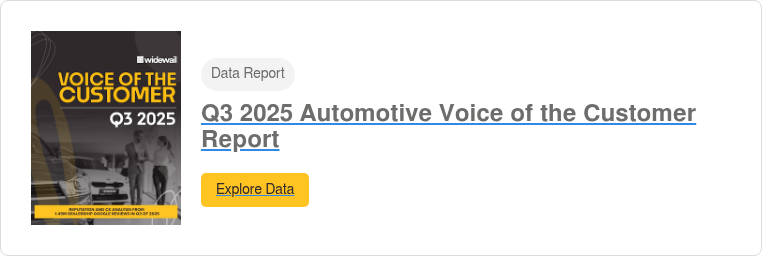It's easy to get caught up in review numbers. The more reviews the better, right? But focusing solely on quantity misses the key: understanding the content.
Rather than just chasing numbers, dive into the details. Use topic tagging and sentiment analysis to uncover what’s working, what isn’t, and where you can enhance the experience. That’s how you stay ahead.
In this post, we’ll cover topic tagging and how you can use it to get the most out of your reviews.

The Common Misconception: More Reviews = More Success
A high review count can improve credibility and SEO, but it doesn’t give you the full picture. What matters most is listening to customer feedback and responding.
Going Beyond Review Quantity
Topic tagging and sentiment analysis provide deeper insights into your feedback. Rather than just seeing an overall rating, you get a clear view of specific pain points and areas of strength, helping you make data-driven improvements.
For example, imagine your dealership has 500 Google reviews and a 4.2-star average. At first glance, this looks like success. However, after using sentiment analysis and topic tagging, you spot a trend: recent reviews mention long wait times and incomplete service.
Though these issues haven't significantly impacted your rating yet, without proper tracking, they could go unnoticed. By identifying these concerns early, you can take proactive steps—like adjusting service communication or retraining staff—to improve the customer experience and protect your dealership's reputation.
What Is Topic Tagging?
Topic tagging helps you make sense of your reviews. Powered by AI, it groups similar mentions into categories, like Staff Performance or Maintenance/Repair automatically, saving you time and effort.
Instead of having to read every review (which is not realistic for someone running a business), you get an instant high-level view of what your customers care about—and how often certain topics come up. For example:
- “My sales person was so helpful” → Staff
- “They got my car fixed in under an hour” → Maintenance/Repair
Widewail tags reviews across 25 different categories so you can spot recurring trends, track changes over time, and zero in on what’s improving—or slipping. Common topics include:
- Staff
- Communication
- Wait times
- Friendliness
- Service quality
- Professionalism
How It Works
Every piece of written feedback, whether from your reviews or surveys, goes through Widewail’s AI analytics layer. Our AI scans the content using Natural Language Processing (NLP), identifies relevant topics, and evaluates review sentiment as positive, negative, or neutral.
This systematic approach provides you with a clear picture of what topics are most frequently mentioned by your customers and how they affect your customer experience.
Why Measure Topic Performance?
Review volume tells you how many people are talking. Topic tagging tells you what they’re talking about—and why it matters.
With topic data, you can:
- Catch problems early. Spot rising complaints about wait times or poor communication before they hurt your reputation.
- Track the impact of changes. See if customers notice (and like) your new booking system or the newest special.
- Support your team. Identify feedback trends tied to employee performance and focus training where it’s needed most.
Widewail Feature Spotlight: The Topic Tags Report:
The Topic Tags Report makes it easy to measure and monitor what customers are talking about—and how they feel about it. In the report, you’ll see:
- How often each topic is mentioned
- The average rating of those reviews
- The sentiment breakdown (positive/negative)

Track topic trends over time, spot big changes in volume or sentiment and understand what’s driving your scores. Plus, with Widewail’s Benchmarking capabilities, you can compare your topic trends to the rest of the industry. Want to know if “friendliness” shows up more—or less—in your reviews than your competitors’? Now you can.
Marketing Impact: Leveraging Insights to Strengthen Brand Messaging
Understanding customer feedback isn't just for operational improvements—it also plays a crucial role in marketing. When you integrate topic tagging into your review strategy, you can:
- Stay ahead of trends and anticipate shifting customer expectations rather than react to them.
- Highlight positive feedback in promotional materials (e.g., "Customers love our friendly service!")
- Address common concerns transparently in advertising and get ahead of any issues
Tailor brand messaging to what your audience cares about most.
Topic Tagging in Action: Communication Trends in the Automotive Industry
The 2024 Voice of the Customer Report, analyzing over 8 million reviews, revealed one clear trend: communication is a top pain point for automotive customers. It's the leading driver of negative reviews—and the problem is intensifying, with dissatisfaction increasing by 6.4% year-over-year.
So, what’s behind this rising frustration?
Today’s car buyers are armed with information—they’ve researched online, they’re well-informed, and they expect clarity and transparency. They want straight answers and a sales team that’s not just reciting scripted responses, but genuinely addressing their needs.
But too often, dealerships miss the mark. When customers feel their expectations aren’t met, trust erodes, and frustration sets in.
Topic tagging and sentiment analysis have now spotlighted communication as a critical issue in 2025. The good news? Dealers have the tools to take action. By addressing communication gaps head-on, dealerships can regain customer trust and prevent these issues from escalating further.
Start Tracking
If you’re only focused on getting more reviews, you’re missing out on valuable insights that can drive real improvements for your business.
With topic tagging and sentiment analysis, you can spot emerging issues, track the impact of changes, and understand exactly what your customers care about—before it costs you.
Start turning everyday feedback into your competitive advantage.











U3GM Blog Post Comments